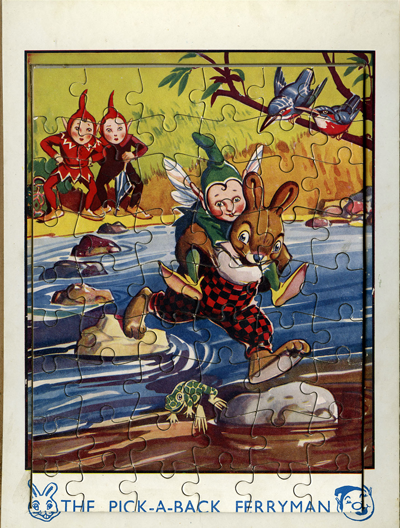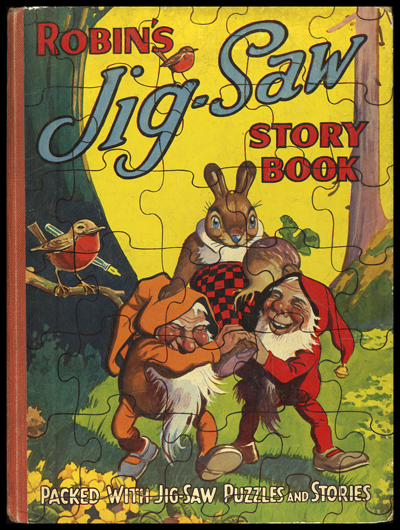

Robin’s Jig-Saw Storybook: Packed with Jig-saw Puzzles and Stories (1938)

Robin’s Jig-Saw Storybook: Packed with Jig-saw Puzzles was published in 1938 by the John Leng & Co. publishing house in London. Common during this period of time was a presentation of anthropomorphism, and “Robin’s Jig-Saw” is no exception with the animals exhibiting human characteristics. Following World War I and pre-World War II, there was a beginning of a “second Golden Age” of children’s literature which illustrated a resurgence focusing on the importance of literature for children. .
Toy books were not new in 1938. John Newbery, credited with discovering a market for children’s books in the 18th century, introduced the idea with his Little Pretty Pocket Book, published in 1744 where children were offered a toy to accompany the book. For a mere two pence more, boys received a ball, and girls, a red and black pincushion.
Newbery’s intent was not to enlist children’s interests in the written word through play. His intent was to impart moral teachings, and the accompanying toys were part of the lesson. His statement to the girls suggests that they put a pin on the red side of the cushion when they did something good. When they were bad, the pins were to be placed on the black side. With ten pins in red, a girl would receive a penny, if the black side was populated with pins, she was given a rod. Even though Newbery introduced toy books, the messages were still didactic.
Some of the didacticism disappeared during the first Golden Age of children’s literature (1880s through the early twentieth century). It was a time that books were written to appeal to the imagination of the child and when vivid illustrations illuminated the stories. This “second” Golden Age of children’s literature occurred following World War II, which benefitted the baby boom generation who had access to quality, affordable children’s literature.
Robin’s Jig-Saw Story Book was published right in between World War I and World War II, so it was created close to the second Golden Age. The book was a harbinger of things to come. The publisher encourages interaction with the story and the book by allowing young readers to read the story on the verso (left) and put together a jig-saw puzzle on the litho (right). The verso contains the story and a black and white image of the puzzle. That way children can follow the black and white image as a guide for placing the colorful pieces together, which serves as the illustration of the story. To see how this works, you can view the item online.

The book is comprised of five stories about a bunny named Lop-Ears, whose ears hang down. Lop-Ears is the oldest of his parents’ “children,” and he is a good citizen, willing to help his parents with their large family, and willing to help others solve problems.
Each story has a different title. The one featured here is the first story, which is titled “Pick-A-Back Ferryman.” Lop-Ears encounters some “dismal” pixies (small, elfin like creatures) who have been invited to their cousins’ picnic. However, they have encountered a stream, and the stones are too far apart for them to safely cross. Lop-Ears volunteers to carry each pixie across the stream in “pick-a-back” (an early phrase that evolved into piggy-back) fashion so they won’t get their feet wet.
This book, new to the de Grummond Collection, is an unusual book comprised of five (5) litho on board jig-saw puzzles, each relevant to a chapter of the story. The content includes the Pick-a-Back Ferryman, The Bunnies' Nannie, Lop-Ears' Doh-Ray-Me!, Freddy Fox's Bogey Man, and The Funny Christmas Cracker. There are anthropomorphic animals throughout. Each jig-saw puzzle includes 45 pieces.
You can view this book by visiting the 3rd floor of McCain Library & Archives. The library is open Monday-Friday from 9:00 a.m. to 4:00 p.m.
For more information, contact Ellen Ruffin at the de Grummond Children’s Literature Collection at or 601.266.6543.